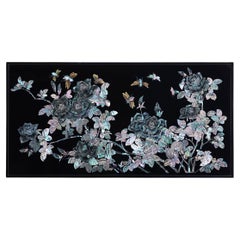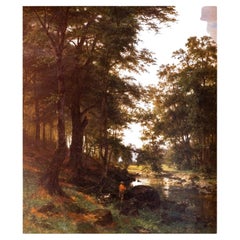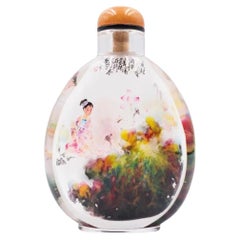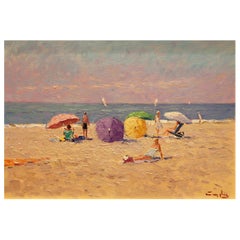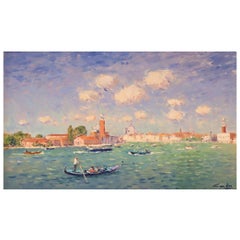Asia - Paintings
109
12
10
to
9
12,801
6,881
131
124
130
12
5
2
26
41
42
22
20
5
11
3
1
4
1
1
1
3
1
Height
to
Width
to
67
44
42
34
29
88
70
53
30
13
5
4
3
2
1
Item Ships From: Asia
Orginion Map
By Taras Yoom
Located in วัฒนา, TH
The «Orginion Map» painting depicts only a small part of Orginion and its view from above. These are the first scenes, which were seen by Aspr1m, when he was on his way to the planet...
Category
2010s Thai Asia - Paintings
Materials
Canvas, Acrylic
Handcrafted Unique Painting on Wood Panel by Arijian Rose 02
By Arijian, Jian Yoo
Located in Namyangju-si, KR
Wall decor handcrafted mother of pearl rose painting on wood panel by Arijian.
Category
2010s South Korean Asia - Paintings
Materials
Wood
German Landscape by Friedrich Carl Werner Ebel
By Friedrich Carl Werner Ebel
Located in Lantau, HK
Friedrich Carl Werner Ebel also known as Fritz Ebel, Lauterbach (Hasse), 1835 - Dusseldorf, 1895
Idyllic scene in a beech grove, 1868 oil on canvas
Signed and date lower right: F. ...
Category
19th Century German Antique Asia - Paintings
Materials
Paint
Inside Painted Crystal, "Young Girl of Elegance" Snuff Bottle by Li Yingtao 2016
By Li Yingtao
Located in Tainan, TW
Li Yingtao, an owner of Yizhenzhai, was born in Hengshui City in 1963. He was praised as a Chinese master of splashing color in inside painting, a Master of Arts and crafts in Hebei Province, and the founder of splashing color techniques in inside painting. By now, he has been teaching and passing down this technique to his students.
Mr, Li Yingtao is one of the most outstanding disciples of the master of Chinese arts and crafts...
Category
21st Century and Contemporary Chinese Modern Asia - Paintings
Materials
Rock Crystal
Impressionistic Beach Scene by Niek Van Der Plas
By Niek van der Plas
Located in Lantau, HK
Niek van der Plas paints impressionist scenes of Holland's beaches and dunes, bulb fields, city scenes in Amsterdam and Maastricht, and other typically Dutch vistas such as the harbo...
Category
21st Century and Contemporary Dutch Modern Asia - Paintings
Materials
Canvas
Niek van der Plas, Venise, Oil on Canvas
By Niek van der Plas
Located in Lantau, HK
Niek van der Plas paints impressionist scenes beaches, dunes, bulb fields, city scenes. Figures are often central in the work of this painter, who was born in 1954 and who is notable...
Category
Late 20th Century Dutch Modern Asia - Paintings
Materials
Canvas
Contemporary Hand-Painted Japanese Screen of Cranes by the River
Located in 10 Chater Road, HK
The cranes by the river painting of this two-panel screen is hand-painted in watercolor, on squares of gold leaf which are applied by hand to the paper base over carefully jointed wo...
Category
2010s Chinese Asia - Paintings
Materials
Gold Leaf
Bali Hindu Textile Framed 'Kamasan' Painting, Indonesia C. 1950
Located in Jimbaran, Bali
A mid-20th century 'Kamasan' cotton textile painting from Bali, Indonesia. The hand-painted image has great detail and depicts Balinese Hindu mythology. Key features of this image ar...
Category
1950s Balinese Folk Art Vintage Asia - Paintings
Materials
Cotton, Paint
Contemporary Hand-Painted Japanese Screen of Red Plum Blossom and Birds
Located in 10 Chater Road, HK
The red plum blossom and birds painting of this two-panel screen is hand-painted in watercolor, on squares of gold leaf which are applied by hand to the paper base over carefully joi...
Category
2010s Chinese Asia - Paintings
Materials
Gold Leaf
Small Wall Hanging Art / Japanese paper / Sand paint / Ink
Located in Iwate-gun Shizukuishi-cho, Iwate Prefecture
This is a small wall hanging picture.
Japanese paper is pasted and colored on wooden panels.
In addition, sand-like paint is layered and partially colored with ink.
The boundary o...
Category
21st Century and Contemporary Japanese Asia - Paintings
Materials
Sandstone
Chinoiserie Hand-Painted Wallpaper Panels of Golden Pavilions on Black
Located in 10 Chater Road, HK
The fine wallpaper panel was hand-painted in gilt paint on rice paper, reproducing the 19th century Chinese export chinoiserie painting of golden pavilions on export wallpaper, from ...
Category
21st Century and Contemporary Chinese Chinoiserie Asia - Paintings
Materials
Paper
A workbench used by a lacquer craftsman/Before 1972/Like an abstract painting
Located in Sammu-shi, Chiba
We have a unique Japanese aesthetic sense.
And only we can introduce unique items through our purchasing channels in Japan and the experience we have gained so far, in such a way tha...
Category
Late 20th Century Japanese Showa Asia - Paintings
Materials
Pine
French Officer Portrait Oil-On-Copper c. 1830
Located in 263-0031, JP
A very rare oil-on-copper portrait of a French officer from Louis Philippe period of 1830-48. Paintings on copper sheeting are typically found only among the genre of small devotiona...
Category
Mid-19th Century Louis Philippe Antique Asia - Paintings
Materials
Copper
French Oil On Canvas Portrait of a Man c. 1800
Located in 263-0031, JP
French oil on canvas portrait of a man c. 1800. The bourgeois gent depicted here displays the cliched hand-in-waistcoat mannerism of the 18th and early 19th century. He’s wearing wha...
Category
Early 19th Century French Antique Asia - Paintings
Materials
Canvas
French Oil On Canvas Portrait of a Woman c. 1835
Located in 263-0031, JP
A French oil-on-canvas portrait of a woman from the Louis Philippe period of 1830-48. Her ensemble and hairstyle place her to the mid-1830s. The canvas is in good unlined condition (...
Category
Mid-19th Century French Antique Asia - Paintings
Materials
Canvas
Early 18th-Century Baroque Portrait of a Nobleman
Located in 263-0031, JP
An oil-on-canvas full-scale portrait of a standing man in costume typical of the Baroque era of c. 1720, France. Purchased from a dealer in Geneva, Switzerland. The canvas is in good...
Category
Early 18th Century French Antique Asia - Paintings
Materials
Canvas
Young French Girl Portrait c. 1800 Oil On Canvas
Located in 263-0031, JP
Neoclassicism saturates this droll portrait of a French girl c. 1800: the high-waisted dress, the antique hairstyle "a la Titus” complemented with m...
Category
Early 18th Century French Neoclassical Antique Asia - Paintings
Materials
Canvas
Louis Philippe-Era Oil on Canvas Portrait of a Woman
Located in 263-0031, JP
Oil-on-canvas portrait of an elegant woman from the Louis Philippe Era (1830-48). The canvas and original frame are in excellent condition.
Category
Mid-19th Century French Louis Philippe Antique Asia - Paintings
Materials
Canvas
Japanese Antique Folding Screen "雨路風 " 1974 /Mingei Wabisabi/
Located in Sammu-shi, Chiba
If you want something special, we recommend purchasing items selected by BROOD.
We sell carefully selected old Japanese items.
I've seen tens of thousands of items so far.
Based on t...
Category
1970s Japanese Showa Vintage Asia - Paintings
Materials
Paper
Early 19th Century French Oil-On-Canvas Portrait of Boy
Located in 263-0031, JP
French oil-on-canvas portrait of boy. Dating from the Louis Philippe Era of 1830-45, this charming portrait is done in a naive manner that evokes American portraiture from the same p...
Category
1840s French Louis Philippe Antique Asia - Paintings
Materials
Canvas
17th Century Oil Painting School of Claude Lorrain
By (after) Claude Lorrain (Claude Gellée)
Located in 263-0031, JP
A copy of the 1636 painting “River Ford” by the French proto-plein-air painter Claude Lorrain (1600-1682). This suivier, or follower, has faithfully reproduced the original but revis...
Category
17th Century European Antique Asia - Paintings
Materials
Canvas
Portrait of Gilles Armand Vaquier de la Baume c. 1825
Located in 263-0031, JP
Bourbon Restoration portrait of French man. Dating from c. 1825, this handsome oil on canvas painting depicts a *homme bourgeois* displaying all the earmarks of the of the less-milit...
Category
1820s French Antique Asia - Paintings
Materials
Canvas
Lepoittevin Early 19th Century Marine Oil Painting
By Eugene Le Poittevin
Located in 263-0031, JP
A marine tableau, oil on wood board, by the French Romantic painter Eugène Lepoittevin (1806-1870). The signature “Poitevin” appears in the lower right: our painter seems to have gon...
Category
Mid-19th Century French Antique Asia - Paintings
Materials
Canvas
Early 19th Century Oil Painting French Family Portrait
Located in 263-0031, JP
The term “Biedermeier” was first wielded as mildly disparaging designation for the bourgeois domesticity, so idealized by German society in the post-Napoleonic era prior to the 1848 ...
Category
Early 19th Century French Biedermeier Antique Asia - Paintings
Materials
Canvas
Eighteenth-Century Portrait of an Italian Man
Located in 263-0031, JP
An oil-on-canvas portrait of an Italian nobleman from the period c. 1760. The subject poses in front of his extensive library. The canvas and frame are in excellent condition. The ma...
Category
Mid-18th Century European Antique Asia - Paintings
Materials
Canvas
18th Century Italian Nobleman Portrait Oil On Canvas
Located in 263-0031, JP
A handsome oil on canvas of an Italian nobleman c 1770. His droll expression is complemented by his galant powdered wig and three-cornered hat tucked under his left shoulder. The fra...
Category
Late 18th Century Italian Antique Asia - Paintings
Materials
Canvas
Abstract Painting by Venezuelan Artist Alejandro Rios
Located in Jimbaran, Bali
An abstract painting by Venezuelan artist Alejandro Rios. Rios is known for creating largely abstract landscapes that disappear through the texture a...
Category
Late 20th Century Venezuelan Modern Asia - Paintings
Materials
Canvas, Paint
1822 Signed and Dated Oil On Canvas Portrait of a Man
Located in 263-0031, JP
A charming oil-on-canvas of a man from the reign of Louis XVIII (1815-24). On the reverse, the following inscription can be found: "Erra, Pinxit” (“Painted by Erra”) and date of Marc...
Category
1820s French Antique Asia - Paintings
Materials
Canvas
French Oil on Panel Painting of a Woman c. 1815
Located in 263-0031, JP
French oil on panel painting of a woman. Composed on a wooden panel, this c. 1815 oil depicts a woman displaying the exaggerated, theatrical mannerisms of the Neoclassical style that...
Category
Early 19th Century French Neoclassical Antique Asia - Paintings
Materials
Wood
18th Century Oil Painting Portrait of Petrus Chevallier
Located in 263-0031, JP
A charming French 18th-century oil-on-canvas portrait of a pharmacist named Petrus Chevallier. Signed “Davila” verso, where it also dated “20 - 09 - 1753" and the title “Petrus Cheva...
Category
1750s French Antique Asia - Paintings
Materials
Canvas
Hand Painting Two Climbing Pandas by Famous Chinese Artist Wang Shengyong
By Wang Hing & Co.
Located in 景德镇市, CN
This Hand Painting of Two Climbing Pandas is a truly special collectible piece by Famous Chinese Artist Wang Shengyong
Painting Details:
Material: paper
Painting paper size: 68 cm ...
Category
2010s Chinese Other Asia - Paintings
Materials
Paper
Yoko Hiramaru, "Sweet Conversation", 2016
By Yoko Hiramaru
Located in Edogawa-ku Tokyo, JP
"Sweet Conversation" by Yoko Hiramaru, oil paint on linen.
Category
21st Century and Contemporary Japanese Asia - Paintings
Chinoiserie Handpainting of Export Wallpaper Panels with Trees, Flowers & Birds
Located in 10 Chater Road, HK
The pair of original paintings inspired by the 19th century Chinese export trade chinoiserie paintings of tree, flower & bird motif on wallp...
Category
2010s Hong Kong Chinoiserie Asia - Paintings
Materials
Paper
Early 20th Century Japanese Screen Pair - Ink Pine Trees on Gold
Located in Kyoto, JP
Imao Keisho (1902-1993)
Pine Trees
Early 20th Century, Circa 1930
Pair of six-panel Japanese screens. Ink on silk and gold leaf.
Dimensions: Each screen H. 67.5” x 148” (172 cm x 376 cm)
A pair of monumental six-panel Japanese pine screens by the renowned Nihonga artist Imao Keisho. Here Keisho entirely removed the background and brought the pine trees to the surface of the painting. This simplification of the elements makes the scene exceptionally direct and compelling and injects a very modern...
Category
Early 20th Century Japanese Showa Asia - Paintings
Materials
Gold Leaf
Early 20th Century Japanese Cherry Blossom Screen by Kano Sanrakuki
Located in Kyoto, JP
Cherry Blossoms
Kano Sanrakuki (1898-1981)
Showa period, circa 1930
2-panel Japanese Screen
Color, gofun and gold leaf on paper
Against a backdrop of gold-leafed ground, the lichen covered trunk and branches of the life-sized cherry blossom tree reach out and beyond the confines of the pictorial surface. The overall composition has a feeling of flatness which draws emphasis to the surface and the three-dimensionality of the cherry blossoms. Painstakingly built-up layers of thickly applied shell-white gofun detail the voluminous blossoms and cover large areas of this tour-de-force of Japanese Nihonga painting. By simplifying the background, minimizing the number of colors and depicting the blossoms with such heavy relief, the artist has emphasized the stunning presence of the cherry tree. The type of tree depicted is the Yae-Zakura; a double-layered type of cherry blossom famed for its beauty and strength. When we think of Japanese cherry blossoms, the first thing that comes to mind is Somei Yoshino variety, which has a single flower with five almost white petals. This type is fragile and easily blown away by strong wind or rain. Most of the double-flowered cherry blossoms begin to bloom when the Somei-Yoshino falls, and the flowering period lasts longer than that of the Somei-Yoshino.
Kano Sanrakuki originally studied painting at the Kyoto City Arts and Crafts School under the tutelage of Yamamoto Shunkyo...
Category
Early 20th Century Japanese Showa Asia - Paintings
Materials
Gold Leaf
Wall Decor Handcrafted Painting on Wood Panel by Arijian Chrysanthemum 03
By Arijian, Jian Yoo
Located in Namyangju-si, KR
Wall Decor handcrafted mother of pearl Chrysanthemum painting on wood panel by Arijian.
Category
2010s South Korean Asia - Paintings
Materials
Wood
Mid-18th Century Japanese Screen Pair, One Hundred Flowers, Chrysanthemums
Located in Kyoto, JP
Omori Soun (b. 1704)
Chrysanthemums - One Hundred Flowers
A Pair of Six-fold Japanese Screens. Ink, color, gofun and gold leaf on paper.
Dating ...
Category
Mid-18th Century Japanese Edo Antique Asia - Paintings
Materials
Gold Leaf
Japanese Kimono Art / Kimono Wall Art / Oil Painting, Lys Blanc
Located in Shibuya City, Tokyo
Kimono Wall Art by Kimono-Couture
Title:Lys Blanc
Prepare to be captivated by the extraordinary beauty of our exceptional oil painting, where a Japane...
Category
21st Century and Contemporary Asia - Paintings
Materials
Silk
Bali Hindu Textile Framed 'Kamasan' Painting, Indonesia, circa 1900
Located in Jimbaran, Bali
A Mid-20th Century 'Kamasan' cotton textile painting from Bali, Indonesia. The hand painted image has great detail and depicts Balinese Hindu mythology. This textile painting is stre...
Category
Early 1900s Balinese Folk Art Antique Asia - Paintings
Materials
Cotton, Paint
Lake Side: Copy of Kuroda Seiko's Painting, Painting, Oil on Canvas
Located in Fukuoka, JP
Introducing a remarkable oil painting on linen canvas, meticulously reproduced to capture the essence of the renowned work by Kuroda Seiki. The original masterpiece, titled "Lake Sid...
Category
20th Century Japanese Asia - Paintings
Materials
Canvas, Linen, Wood
19th Century Japanese Screen Pair. Flowers & Birds of the Four Seasons
Located in Kyoto, JP
Flowers & Birds of the Four Seasons
Pair of six-fold Japanese Screens. Ink, color, gofun and gold on paper.
Second half of the 19th Centur...
Category
Late 19th Century Japanese Meiji Antique Asia - Paintings
Materials
Wood, Paper
Antique hanging scroll of Japanese cat/Late Edo-Meiji period/Cat painting
Located in Sammu-shi, Chiba
This is a picture of a cat drawn by a person named "Toshizumi Nitta" from the end of the Edo period to the beginning of the Meiji period.
She is a very simple and cute cat.
He is a vassal of the Tokugawa Shogunate, born in Ota City, Gunma Prefecture (southern part of Gunma Prefecture).
He was related to the Tokugawa family and lived in a large mansion in the Ota clan in Gunma prefecture.
However, the Nitta family's territory was very small, and they were by no means a wealthy vassal.
He seems to have lived quite poorly.
So he painted cats and sold them to people.
The Nitta family continued to draw pictures of this cat for four generations.
"Nitta toshizumi" is equivalent to the fourth generation.
During the Edo period, sericulture was thriving in the Kanto region.
Cats were said to be the gods of silkworms, as they drive away mice, the natural enemies of silkworms.
It was the Nitta family who drew such a cat on paper, pasted it in the silkworm chamber, and sold it as a mouse repellent.
There were also other monks who painted pictures of cats, but the Nitta family in particular was related to the Tokugawa family, so people believed that paintings of cats had special powers. , a lot of paintings...
Category
Late 19th Century Japanese Edo Antique Asia - Paintings
Materials
Paper
Handcrafted Floral Painting on Wood Panel by Arijian Chrysanthemum 02
By Jian Yoo, Arijian
Located in Namyangju-si, KR
Handcrafted mother-of-pearl painting with Chrysanthemum design.
Category
2010s South Korean Asia - Paintings
Materials
Wood
Hu Jie Ming Early Work
Located in Fukuoka, JP
The item is an early artwork of Chinese artist Hu Jieming.
Hu Jieming's groundbreaking artwork, recently sold at a Christie auction for 3500 pound sterlings, showcases his innovative approach to digital media and video installation...
Category
20th Century Chinese Asia - Paintings
Materials
Paper
"Awaiting" Painting by Leonid Steele, Famous Ukrainian Artist
Located in Fukuoka, JP
A stunning painting by Ukrainian artist Leonid Steele titled "Awaiting", created in 1972 during the Soviet era. The painting is in the human realist st...
Category
20th Century Ukrainian Asia - Paintings
Materials
Cotton
17th Century Japanese Screen. Ink Plum Tree & Birds by Kano Naonobu.
Located in Kyoto, JP
Kano Naonobu (1607-1650)
Plum Tree and Birds
Six-fold Japanese Screen. Ink and slight color on paper.
In this evocative ink work spread over a six-panel folding screen, we see the consummation of the elegance and refinement of the Edo Kano school. This 17th century screen is a rare surviving example of a large-scale bird and flower painting by Kano Naonobu, the younger brother of Kano Tanyu...
Category
17th Century Japanese Edo Antique Asia - Paintings
Materials
Wood, Paper
17th Century Japanese Screen Pair. Tiger & Dragon by Kaiho Yusetsu
Located in Kyoto, JP
Kaiho Yusetsu (1598-1677)
Tiger and Dragon
Early Edo Period, Circa 1650
A Pair of Six-fold Japanese Screens. Ink and slight color on paper.
Dimensions:
Each screen: H. 171 cm x W. 380 cm (67.5’’ x 149.5’’)
In this pair of early Edo period Japanese screens a group of tigers prowl in a bamboo grove whipped with fierce wind, while a dragon claws through clouds and mist. The dragon embodies elemental qualities - looming out of the mist, the coils of its body disappearing in the clouds. The dragon is calling for rain, symbolizing spring which is considered the fountain of life. On the other side, the tigers calls for the wind, symbolizing autumn which is considered the end of life. Tigers were familiar motifs within Japanese art from ancient times though the animals were imaginary to the people in the 17th century. While dragons and tigers are usually associated as sacred and ferocious, in this painting, both animals have rather amusing expressions. The tigers appear to glare at the dragon with cat-like eyes, and the look on the swirling dragon’s face appears almost affectionate - lending a playful flair to an otherwise magnificent theme.
The tiger and dragon are cosmological symbols of the balancing forces in the world. Screens such as this were originally meant to express the fluctuating nature of the world. For Japanese in the early Edo period, they likely suggested the powers of the cosmos. In Japan the tiger and dragon motif was originally absorbed into the circles of Zen monasteries before spreading into the secular world. The theme especially appealed to the military classes with the Kano school, the official painters to the Shogun and the samurai, being the leading contributors. The painter of this pair of screens, Kaiho Yusetsu (1598-1677), was closely patronized by the third Shogun Tokugawa Iemitsu. In his later years he worked with Kano school artists...
Category
Mid-17th Century Japanese Edo Antique Asia - Paintings
Materials
Silk, Wood, Paper
Handcrafted Landscape Painting on Wood Panel by Arijian
By Arijian
Located in Namyangju-si, KR
Landscape painting with mother-of-pearl inlay by Arijian.
Category
2010s South Korean Asia - Paintings
Materials
Wood
Antique Work Board Used by Japanese Craftsmen/1868-1920/Wabi-Sabi Wall Painting
Located in Sammu-shi, Chiba
If you want something special, we recommend purchasing items selected by Brood.
We sell carefully selected old Japanese items.
I've seen tens of thousands of items so far.
Based o...
Category
Late 19th Century Japanese Meiji Antique Asia - Paintings
Materials
Cedar
Wall Decor Landscape Painting on Wood Panel by Arijian
By Arijian
Located in Namyangju-si, KR
Landscape Painting with Mother-of-Pearl inlay by Arijian.
Category
2010s South Korean Asia - Paintings
Materials
Wood
Japanese Painting, Hanging Scroll, 19th Century Bamboo in Moonlight
Located in Kyoto, JP
Bamboo in moonlight
Gamo Rakan (1784-1866)
Hanging scroll, ink on silk.
Dimensions:
Scroll: 201 cm x 58 cm
Image: 137 cm x 45 cm
In this early 19th century work by Gamo Rakan a light ink wash applied to the silk background silhouettes the moon and suggests the atmosphere of early evening. Even though it is a literati subject, Rakan’s bamboo is quite realistic with a strong decorative style. The painting finds its inspiration from Chinese Ming dynasty painters who often used a single-tone, jet black stroke to emphasize the calligraphic nature of bamboo.
In a different era, decorative would have been seen as somewhat unrefined. But increasingly in the Edo period, it was the hallmark of high style. The Japanese people, in particular the rising merchant class, had gradually become apathetic toward the traditional Sesshu and Kano schools of painting. Chinese professional and amateur painters living in the port of Nagasaki during the 18th century had a profound effect on Japanese painting and the freshness of their style and its decorative appeal contributed greatly to its popularity. Gamo Rakan’s teacher, Tani Buncho...
Category
Early 19th Century Japanese Edo Antique Asia - Paintings
Materials
Silk
Early 19th Century Japanese Screen. Cherry Blossom & Pheasants by Mori Tetsuzan
Located in Kyoto, JP
Mori Tetsuzan (1775-1841)
Pheasants and Cherry Blossoms
Two-fold Japanese screen. Ink, color, gofun, gold and silver on paper.
A two-fold Japanese bir...
Category
Early 19th Century Japanese Edo Antique Asia - Paintings
Materials
Gold Leaf
17th Century Japanese Screen Pair, Cranes
Located in Kyoto, JP
Cranes
Anonymous, Kano School.
Edo period, second half of the 17th century.
Pair of six-panel screens. Ink, pigment gofun and gold l...
Category
1670s Japanese Edo Antique Asia - Paintings
Materials
Gold Leaf
Meiji Period Japanese Screen Pair, One Hundred Birds by Hasegawa Gyokujun
Located in Kyoto, JP
One hundred birds
Hasegawa Gyokujun (1863-1921)
Meiji period, circa 1900.
Ink, color and gofun on silk.
Dimensions of each screen:
H. 170 cm x W. 190 cm (67’’ x 75”)
Despite the title, well over 100 birds are represented in this pair of two-fold Japanese screens (the title functions figuratively to convey the idea of a large number). The monumental work is rendered with a comprehensive and highly complex composition which is exquisitely executed and meticulously colored. More a celebration of naturalism than the traditional “One Hundred Birds” paintings which originated in China. This was a subject matter known for its auspicious meaning as much as its actual depiction of nature. These paintings generally had a phoenix (occasionally peacocks) placed in the center, and the other birds paying homage to it.
In this quintessentially Japanese scene painted by Gyokujun, a couple of long-tailed birds modeled after paradise flycatchers are included; these are traditional auspicious motifs in Oriental bird and flower painting and denote themes such as celebration and enduring generations. In addition there is the playful inclusion of single exotic parrot. Even so, the vast majority of the birds and flowers are native to Japan. Reading the scene from right to left, from spring through to autumn, the overwhelming sense is one of movement and haste. It is almost as if the birds are in a race, with the fleetest leading the way forward. Although these native birds were commonly drawn amongst artists of the Shijo school, rarely were they painted with such drama and dynamism. It is not strictly a depiction of sketched birds whose manner was faithfully handed down through the traditions of the Shijo school. Rather we see Gyokujun seeking and achieving new expressions in the heart of the turbulent Meiji period.
Hasegawa Gyokujun (1863-1921) was born in Kyoto. He was the eldest son of Hasegawa Gyokuho, a Shijo school painter who studied under Matsumura Keibun. Gyokujun studied painting under his father and became a prominent member of the Kyoto painti
ng world from a young age. In 1891 he established the ‘Young Painters Social Club’ along with Takeuchi Seiho, Miyake Gogyo and Taniguchi Kokyo. Also in 1891 he was selected as a judge of the Great Private Paintings Exhibition along with Takeuchi Seiho, Yamamoto Shunkyo...
Category
Early 1900s Japanese Meiji Antique Asia - Paintings
Materials
Silk, Wood
19th Century Japanese Shunga Hand-Scroll, Katsukawa School
Located in Kyoto, JP
Shunga
Unknown artist
Meiji era, circa 1880
Hand-scroll mounted with 12 paintings
Ink, pigment and gofun on silk
Dimensions:
Each image measures H. 23.2 cm x W. 34.4 cm (9.15” x 13.5”)
The hand-scroll measures H. 28 cm x W. 540 cm (11” x 212”)
A set of 12 late 19th century Japanese Shunga paintings mounted as a hand-scroll. Two of the leaves bear the signature and seal ‘Setsuzan’, although we are unable to confirm the identity of the artist using this art name. 6 of the 12 images are taken almost directly from Katsukawa Shuncho’s late 18th century woodblock series, ‘Erotic Pictures...
Category
Late 19th Century Japanese Meiji Antique Asia - Paintings
Materials
Silk
19th Century Japanese Screen for Tea-Ceremony, Ink Bamboo and Plum on Gold Leaf
Located in Kyoto, JP
Three Friends of Winter
Nakajima Raisho (1796-1871)
Late Edo period, circa 1850
Ink and gold leaf on paper.
This is a double-sided Japanese Furosaki or tea-ceremony screen from the mid 19th century; bamboo and plum on the front, young pines the back. It by Nakajima Raisho, a master painter of the Maruyama school in the late Edo and early Meiji periods. In this work Raisho combines exquisite ink brushwork with large open spaces of brilliant gold-leaf to inspire the viewers imagination. Rather than naturalism, he is searching for the phycological impression of the motifs, resulting in abstraction and stylization. His simplification of the motifs the result of looking to capture the inner nature of the objects. This art motif is known as Sho Chiku Bai, or the Three Friends of Winter. Evergreen pine connotes steadfastness, bamboo suggests both strength and flexibility, while plum blossoms unfurling on snow-laden branches imply hardiness. Combined, this trio is emblematic of Japanese new year. Chinese literati were the first to group the three plants together due to their noble characteristics. Like these resilient plants flowering so beautifully in winter, it was expected of the scholar-gentleman to cultivate a strong character with which he would be able to show the same degree of perseverance and steadfastness even during times of adverse conditions.
The screen would have been placed near the hearth of a room used for the Japanese tea ceremony, shielding the fire from draughts and also forming a stimulating and decorative backdrop behind the tea utensils. It would have been used in the Hatsugama, or first tea-ceremony of the new year.
Nakajima Raisho (1796-1871) originally studied under Watanabe Nangaku before entering the school of Maruyama Ozui. He was the highest ranking Maruyama school painter at the end of the Edo period and was known as one of the ‘Four Heian Families’ along with Kishi...
Category
Mid-19th Century Japanese Edo Antique Asia - Paintings
Materials
Gold Leaf
Japanese Screen, Early 20th Century Wagtail & Chrysanthemum by Ishizaki Koyo
Located in Kyoto, JP
Ishizaki Koyo (1884-1947)
Wagtail & Chrysanthemum
Early 20th century
Folding screen in two-panels. Ink, pigments and gofun on gold leaf.
Sign: Koyo
Seal: Koyo
This ...
Category
Early 20th Century Japanese Taisho Asia - Paintings
Materials
Gold Leaf
Handcrafted Painting on Wood Panel by Arijian Chrysanthemum 03
Located in Namyangju-si, KR
Wall Decor Handcrafted Mother of Pearl Chrysanthemum Painting on Wood Panel by Arijian.
Category
2010s South Korean Asia - Paintings
Materials
Wood
Recently Viewed
View AllMore Ways To Browse
Retro Pineapple Lamp
Pair Of Wood Bedside Chests
Napoleon Iii Style Cabinet
Vintage Italian 70s Lighting
Vintage Solid Glass Lamps
Pair Cut Glass Table Lamps
Rococo Marble Console Tables
Louis Philippe Walnut Chest
Tall Cabinet On Stand
French Carved Oak Chest Of Drawers
Antique Glass Door Cupboard
Painted Antiques Cabinet Glass Door
Pink Crystal Chandelier
Vintage Italian Brass Table Lamp 1950s
Vinyl Cabinet
White Glass Cylinder Lamp
Plinth Dresser
Pair Blown Glass Pendant Lights

